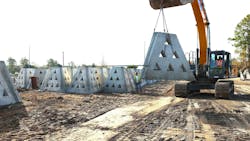Morehead City, N.C. begins island restoration, shoreline stabilization
Construction has commenced for a restoration of Morehead City, North Carolina’s protective barrier island, Sugarloaf Island, according to a press release from Sea & Shoreline LLC.
The project will address the alarming erosion of the island, which has been under threat with each passing storm, jeopardizing its protective capabilities for Morehead City. The work is supported by $6.6 million in North Carolina state legislative funding.
Expert teams will now focus on advanced shoreline stabilization techniques, blending shoreline enhancement with public utility and natural habitat restoration.
Aquatic restoration experts Sea & Shoreline, the North Carolina Coastal Federation, The Town of Morehead City, Quible & Associates, Sandbar Oyster Company, and East Carolina University have spent the last two years studying, designing, planning, and permitting this project to restore and protect the island.
A notable component of this plan and project are Wave Attenuation Devices (WADs). With over 300 of the proposed 1,200 devices already constructed, these offshore breakwater devices are designed to counter erosion by diffusing wave energy, assisting in the reformation of the shoreline through sand accretion, supporting seagrass growth to enhance water quality, and creating essential fish habitat.
This living shoreline project will also include installation of seagrass planting units, saltmarsh plants, and oyster reefs, and is expected to be complete by mid-2024.
The advantages of this initiative include:
- Countering erosion, rebuilding the shoreline
- Amplifying the coastal resilience of Morehead City
- Expanding fish habitats, leading to enhanced fishing opportunities
- Boosting ecotourism
- Improving seagrass presence and overall water quality
- Preventing the loss of trees and shorebird habitat
- Augmenting carbon sequestration


